Someone once told me you can tell how healthy a software project is by the number of
new books each year. For the past few years the MySQL community has been blessed with one or two books each year. Part of that was the major shift with MySQL 8 changes but part of it was that the vast majority of the changes were fairly minor and did not need detailed explanations. But this year we have been blessed with
four new books. Four very good books on new facets of MySQL.
I
ntroducing the MySQL 8 Document Store is the latest book from Dr. Charles Bell on MySQL. If you have read any other of Dr. Chuck's book you know they are well written with lots of examples. This is more than a simple introduction with many intermediate and advanced concepts covered in detail.
 |
| Introducing the MySQL 8 Document Store |
MySQL & JSON - A Practical Programming Guide by yours truly is a guide for developers who want to get the most of the JSON data type introduced in MySQL 5.7 and improved in MySQL 8. While I love MySQL's documentation, I wanted to provide detailed examples on how to use the various functions and features of the JSON data type.
 |
| MySQL and JSON A Practical Programming Guide |
Jesper Wisborg Krogh is a busy man at work and somehow found the time to author and co-author two books. The newest is
MySQL Connector/Python Revealed: SQL and NoSQL Data Storage Using MySQL for Python Programmers which I have only just received. If you are a Python Programmer (or want to be) then you need to order your copy today. A few chapters in and I am already finding it a great, informative read.
 |
| MySQL Connector/Python Revealed |
Jesper and Mikiya Okuno produced a definitive guide to the MySQL NDB cluster with
Pro MySQL NDB Cluster. NDB cluster is often confusing and just different enough from 'regular' MySQL to make you want to have a clear, concise guidebook by your side. And this is that book.
 |
| Pro MySQL NDB Cluster |
Recommendation
Each of these books have their own primary MySQL niche (Docstore, JSON, Python & Docstore, and NDB Cluster) but also have deeper breath in that they cover material you either will not find in the documentation or have to distill that information for yourself. They not only provide valuable tools to learn their primary facets of technology but also provide double service as a reference guide.







